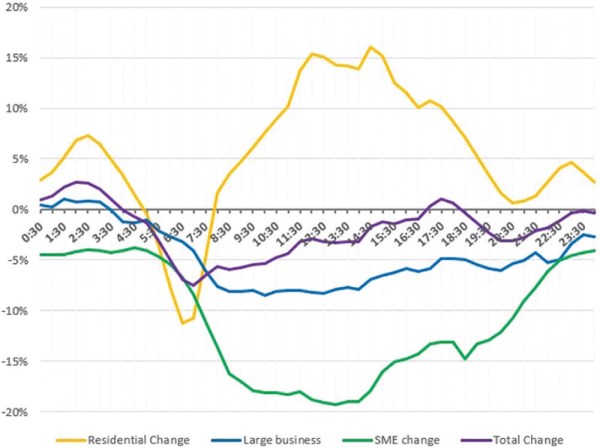How COVID-19 Affected Your Energy

In 2020, most people were affected by dramatic changes to their lives, businesses, income and working arrangements due to COVID-19.
In 2021, the pandemic will continue to have an impact on all of us and the Strata Community, Strata Firms, Committees, Property Owners and Residents alike, are not immune from this. In this review, we will look at 2020 and some of the impacts on energy usage and price, plus savings opportunities for 2021.
The Year That Was – 2020
We are aware, and indeed grateful, that compared to most of the world, Australia fared well in 2020 from a health management perspective and generally, economically. However, the full economic impact is still to be felt, and the pandemic continues to influence energy use and the ability of customers to pay their bills.

Images Source: AEMO & Energy Networks Australia
In March 2020 (gosh that seems like a long time ago now, eh!?), Strata Energy Services supported SCA by providing a Factsheet on COVID-19 and Energy Bill Hardship Policies, and support regulators and energy retailers provide customers. Periodically, the Australian Energy Regulator releases a ‘Statement of Expectations of Energy Businesses’, with a primary focus on protecting customers during the COVID-19 pandemic. The message now, as was then, is that customers who can pay should continue to do so to support the energy sector, but, if you have concerns or difficulty in paying your energy bills, please speak to your supplier.
A key part of this ongoing message is, ‘before 31 March 2021 (and potentially beyond), energy retailers cannot forcibly disconnect customers. This also includes Body Corporates / Owners Corporations, and other large business customers, who on-sell energy to residential and small business customers (i.e. embedded networks), who may be in financial distress. The repeated message for customers is, ‘contact your supplier and don’t be silent’.
2020 Energy Usage Patterns
COVID-19 has had a profound effect on the world and how we live and work. The public health, economic recession and social impacts of this pandemic are all encompassing and frankly yet to be fully understood. In such an uncertain and extraordinary situation, it’s critical to understand our energy supply is secure, and the Australian Energy Market Operator (AEMO) has stated that Australia’s energy systems and markets are currently operating in a safe and secure state, as the nation continues to respond to COVID-19.1
Life has experienced a paradigm shift from what was considered ‘normality’ and in one form or another, working and learning from home, or a hybrid of this, has become the new status quo. Unsurprisingly, this change to our personal and professional routines has had an impact on electricity demand and usage patterns.



There are many factors that affect on any given day, e.g. temperature, day of the week, time of the year, but one thing that is certain, there has been a shift from industrial and commercial, to residential usage profiles.
Early observations by AEMO noted COVID-19 demand reductions predominantly in Queensland and New South Wales. Impacts gradually expanded over time as restrictions tightened, especially in Victoria. Also, morning peaks in all states are now slightly later than usual and afternoon peaks slightly earlier. This would seem to be consistent with changes in commuting patterns with people working and studying from home. Weekday reductions in demand were in the order of 5-10% in the morning, 6-8% in the afternoons, while evening peak is the least impacted, with average reductions of 3-5%. Weekend impacts are lower, with consistent reductions of 5-6% across most of the day except for the evening peak which appears to only have been marginally impacted by approximately 1%.

Interestingly, Australia overall, has seen only moderate reductions in energy demand when compared internationally, particularly in countries like Spain, France and Italy where tighter COVID-19 restrictions and full-lockdowns have been implemented repeatedly. Demand reductions in the order of 20 to 30% have been observed in those countries (source AEMO).
The following graphs show daily demand load profile changes (similar patterns around the country), when lockdown first occurred, and as the community has reopened.
Impact on Price
The east coast electricity wholesale energy market price declined throughout 2020 and stabilised towards the end of the year.
The National Electricity Market wholesale futures contract prices trades remained at comparatively low levels when compared to recent years. Throughout 2020, ‘Calendar Year 2021’ Forward Contracts recorded declines, while the ‘bottom of the curve’ appears to have now flattened. If you have any questions from colleagues or committee members about energy prices and potential savings opportunities, the following Cal-21 wholesale curve graph provides the picture of this backwardation. If you have not recently assessed your clients’ energy costs, you may be missing savings opportunities.2
So Where to From Here – 2021
The Energy Regulators direction to energy suppliers combined with the Government’s economic packages are providing support to affected workers, businesses and the broader community, and has kept Australians in work, and businesses in business.
As we lead with in this article, the full effect of COVID-19 is yet to be felt. While the Australian economy is currently in a recession, a key message you can provide your strata clients, is energy management is not set-and-forget, and there may be a silver lining to the pandemic and an opportunity for you to save some money today.
View Comments
(0)